With so many electric guitars on the market, it can be tricky to know where to start when looking to buy your first guitar. This buying guide aims to help you pick the right electric guitar for you…
The ideal electric guitar is the one that suits your musical style and has the right features to achieve that sound. We’ll break down all the factors you may wish to consider when buying an electric guitar.
The first thing to note is, just like your favourite food, pair of shoes, car, bike, or film, there’s no one “perfect” guitar. Many instruments can be made to do different things in different players’ hands. But if you narrow down the specific features you think you’d prefer, you’ll be able to see which guitars will match your requirements, therefore, finding the most suitable choice for you. This guide aims to help you do that.
The basics
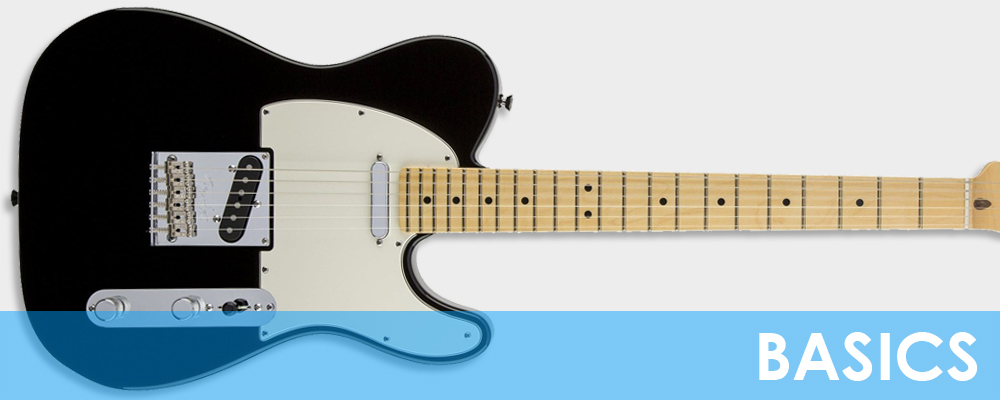
What’s my budget?
Electric guitars come at a huge range of prices, from sub-£100 to well over £2k. When choosing your first guitar, one of the most important factors is your budget.
Spending more money will generally result in better woods, better hardware, better setups, and a more recognisable brand – up to a point. The law of diminishing returns means that, as you begin to spend a lot more money, the improvements will become less obvious for the same increase in price – i.e. it’s not always the case that a £4k guitar (perhaps a vintage model) is twice as good as a £2k guitar.
Fortunately, this means that the more money you spend on a guitar at the lower end of the price spectrum, the more noticeable the improvements will be.
You should also factor in the cost of buying an amplifier, which will vary in price depending on how loud you wish to play (silent, home use, practice, small rehearsals, or full gig volume) and how many additional features you need (headphone output, silent practice mode, AUX-in, Bluetooth etc).
Of course, you don’t have to buy an amplifier to get started; there are many great iOS apps that will let you hear your guitar when used with a special interface. Some players simply start playing guitar without an amp altogether – it’s perfectly fine for getting the basics down!
Some of our guitar packs feature everything you need to get playing, including a guitar, amplifier, and cables. They remove the worry of putting together a guitar rig. If you do decide on a guitar package, however, you’ll still need to know the type of guitar you’d like to buy, so keep reading!
Are aesthetics important?
The aesthetics of your guitar play a huge role when deciding which instrument you should buy. If you have a favourite guitarist who you’d like to sound like, a great starting point is to see what guitars they play and try and match that with the instruments you’re looking at. This is an almost sure-fire way of getting an instrument that will deliver the sound you prefer.
Body
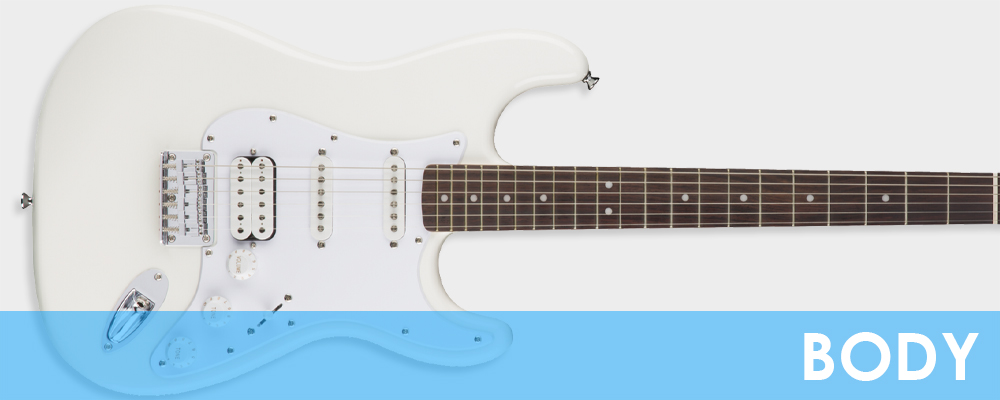
Body Style
Electric guitars come in three body types – solid body, semi-hollow body, and hollow body. Solid body guitars are constructed from solid blocks of wood and are seen as the ‘standard’ electric guitar. Hollow body guitars can either be semi-hollow (with a tone block inside) or completely hollow.
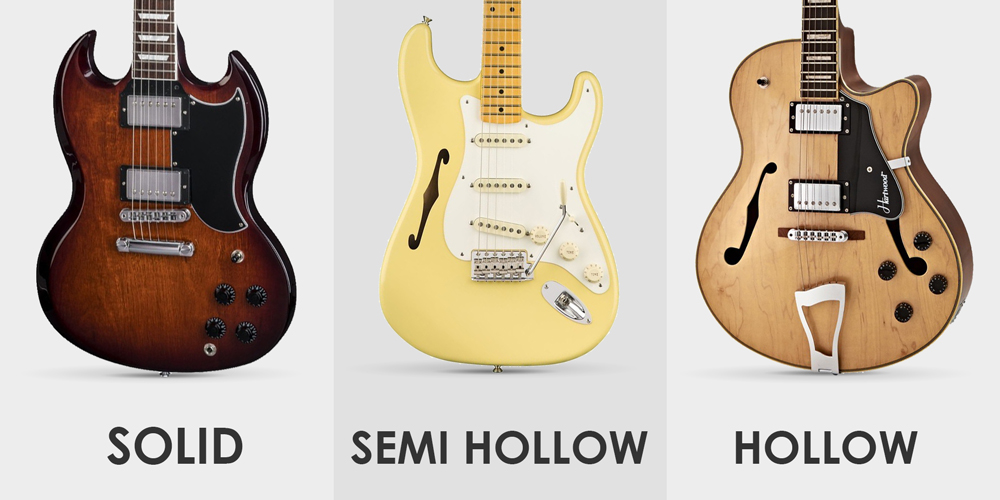
Solid body guitars are the most versatile guitars of all, being capable of playing in all styles of music. The solid body design makes the tone more focused and less prone to feedback. With a simple change of hardware and tonewoods, these guitars can be honed for any style of music imaginable.
Semi-hollow body guitars have a more lively, ‘acoustic’ tone and increased resonance. This comes at the expense of tonal focus. Semi-hollow guitars are more versatile and can cover both clean and overdriven sounds. They’re seen in many genres including jazz, pop, funk, soul, blues, indie, alt-rock, and even rock (think Malcolm Young from AC/DC or Dave Grohl from Foo Fighters).
Completely hollow body guitars have larger bodies and the most resonant ‘acoustic tone’. They’re commonly seen in jazz, where a thick, clean tone with great resonance is required. While completely hollow guitars are perfect for traditional jazz, they’re not ideal for high-gain styles of music, such as rock or metal.
If you’re going for your first electric guitar, a solid body instrument is generally seen as the common ‘standard’ choice. However, if your favourite players use semi-hollow or hollow-body guitars, there’s no reason why you shouldn’t start with one too if you wish to emulate their sound!
Tonewoods
The more expensive the guitar, the more likely the body will be constructed from a solid tonewood rather than a laminate. This influences the quality of the sound and the guitar’s resonance.
The neck usually consists of a separate wood to the fingerboard, as the fingerboard needs to be a harder wood for durability.
Different tonewoods influence the sound of the instrument and sometimes a layering of woods is used to blend the tonal qualities of both. While the full discussion of tonewoods could occupy an entire article on its own, here are a few of the key options:
- Mahogany – warm, resonant, good sustain, good midrange. Commonly used for rock guitars and seen on the neck and body. Similar to koa and korina.
- Maple – bright sound, good ‘attack’ (fast note sounds for clean, funky playing). Commonly used for versatile guitars in rock, blues, indie, and country. A common wood for all parts of the guitar (fingerboard/neck/body). Similar to pine, poplar, paulownia, and ash.
- Basswood – lightweight with a balanced tonality. Commonly used for the bodies of versatile guitars in rock and metal. Similar to alder and poplar.
- Rosewood – a common fingerboard wood. Dark coloured and ‘tight’ articulation of notes with a smooth feel.
Shape
The shape of the body can influence the way the guitar feels to play. The ‘horns’ of the guitar are the most defining features of standard guitar bodies and help categorise the body shape.
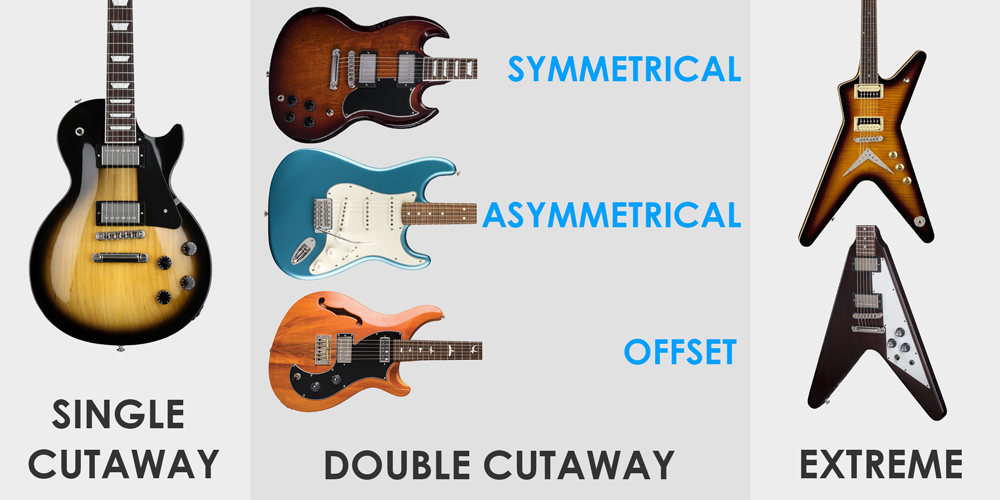
A twin-horned guitar is labelled with a ‘double cutaway’, and it’s these horns that make it easy to access the top of the fingerboard. The double cutaway design may be symmetrical, asymmetrical, or offset – where one half of the body has been shifted off-centre. These guitars offer excellent comfort and easy access to all the frets.
A single-horned guitar is labelled as a ‘single cutaway’. This design makes it slightly harder to access the top of the fingerboard for high-range solo techniques. However, many guitar designs solve this with low-profile neck joints and sculpted horns.
V-shape guitars and extreme body shape guitars are an entity unto themselves! Perfect for those looking to stand out from the crowd but not as ideal when played sat-down.
Neck
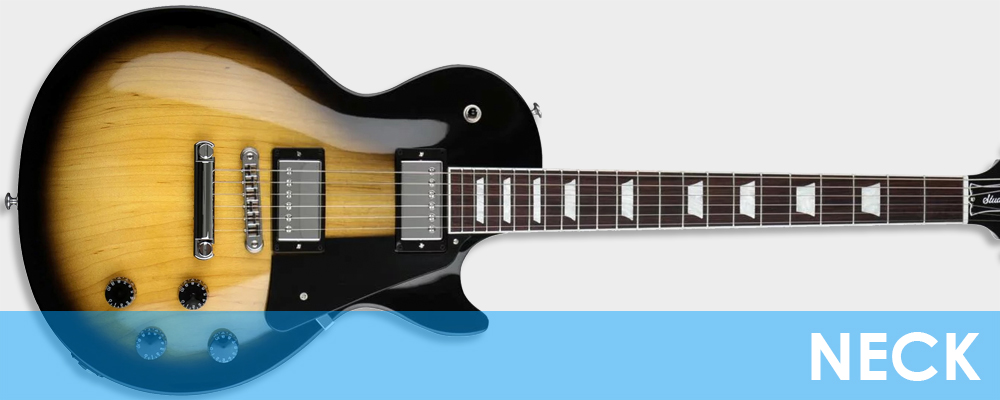
The neck of the guitar influences the playability of the instrument, and small specification changes can create a very different playing feel. For beginners, this will be less noticeable as you’ll have no previous starting point, but there a few specifications to watch out for.
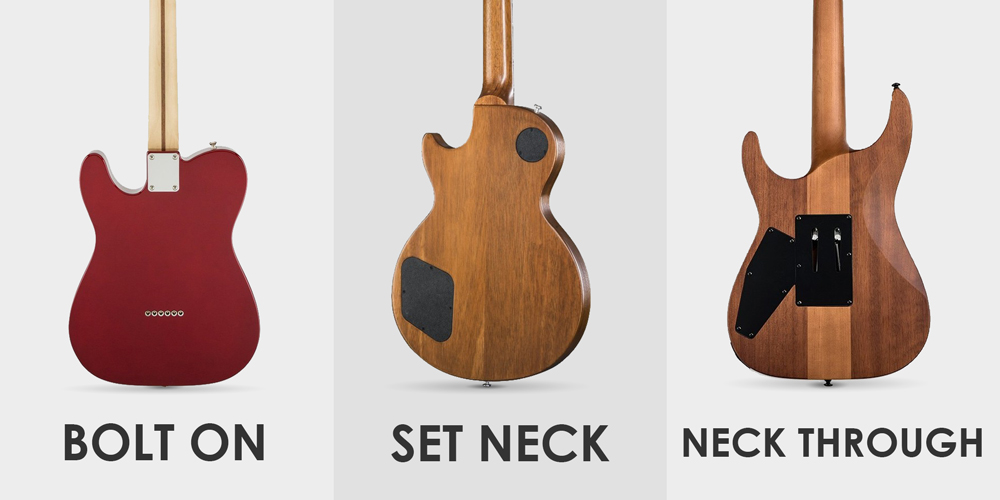
Neck joint
The neck is joined to the body with bolts (bolt-on), glue (set-neck), or a neck-through construction. Each guitar style has its own slightly different sound.
Bolt-on guitars are generally brighter, whereas set-neck guitars have a warmer tone with more resonance. Each guitar style has a slightly different feel – try them out in person, if you can, to see which you prefer!
In general, the bolt-on guitar style is especially popular with Fender guitars and other solid body guitars built for high-speed playing. The set-neck guitar is popular with Gibson, and features on solid body guitars built for rock/blues/metal and hollow guitars built for jazz/blues/soul.
An alternative neck-through construction consists of a single neck block running the entire length of the guitar. Two body ‘wings’ are attached on either side to make the complete body shape. These guitars are rarer but incredibly smooth to play, with no neck joint to hinder upper-fret access. They also have enhanced sustain and resonance.
Number and size of frets
Want to play the fastest, most high-octane playing styles with the widest note range? Chances are you’ll want 24 frets. This is the common maximum number of frets on an electric guitar. The ‘standard’ number of frets, however, is 22 – perfect for soloing and rhythm work – while 21 frets (sometimes 20) is the ‘vintage’ style.
Generally, the bigger the frets, the easier you’ll find string bends and vibratos (two soloing techniques). The downside with ‘jumbo’ frets is you may push too hard and bend the string out of tune.
Smaller fret sizes offer the balance between easy solo techniques and a smooth glide over the strings when traversing the fingerboard. Vintage guitars often have small frets – great for chords but tricky when getting a good ‘grip’ on the strings for modern solo techniques. A ‘medium’ size fret – sometimes ‘medium jumbo’ – is seen as the standard.
Scale length, radius, and neck profile
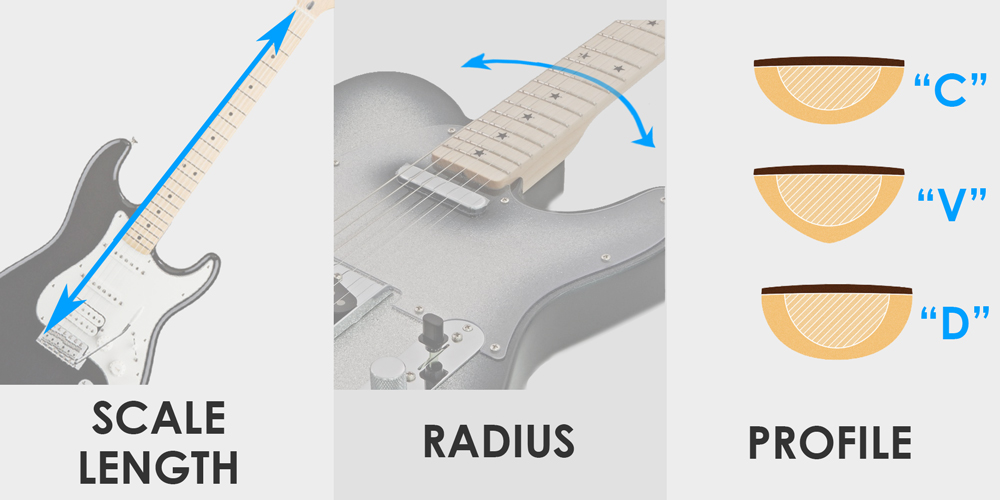
- Scale length: The length of the strings from the nut (at the top of the neck) to the bridge (on the body). A longer scale length gives the guitar more resonance (think the sound of Fender guitars) but make string bends harder, as there is more tension. Shorter scale lengths make string bends and solo techniques slightly easier as there is less tension and the frets are slightly closer together.
Sometimes longer scale lengths are used to create a better guitar for low tunings, used in rock/metal music.
-
- 24” and under: short scale length
- 25” and over: longer scale length
- Fingerboard radius: The fingerboard of the guitar is crafted with a gentle curve – imagine the surface of a cylindrical pipe. The bigger the radius, the flatter the curve will be, and the easier you’ll find crossing the strings for fast soloing techniques.
Smaller radiuses have a bigger curve and are traditionally chosen for easier chord playing.
-
- 7-9”: vintage size. Great for chord playing. Less good for soloing and string bends as the strings may ‘choke’ out as they catch the other frets during bigger bends.
- 9”-12”: standard modern sizes for the perfect balance between chord playing and solo work.
- 12” : a very flat fingerboard for modern playing styles. Great for soloing and providing balance across the strings.
- Neck profile: this is the actual shape of the neck, as it sits in your hand. ‘C’-shaped necks are generally more standard, with a chunky feel in the hand, while ‘D’-shaped necks are slimmer and more popular with high-octane rockers.
Pickups and configurations
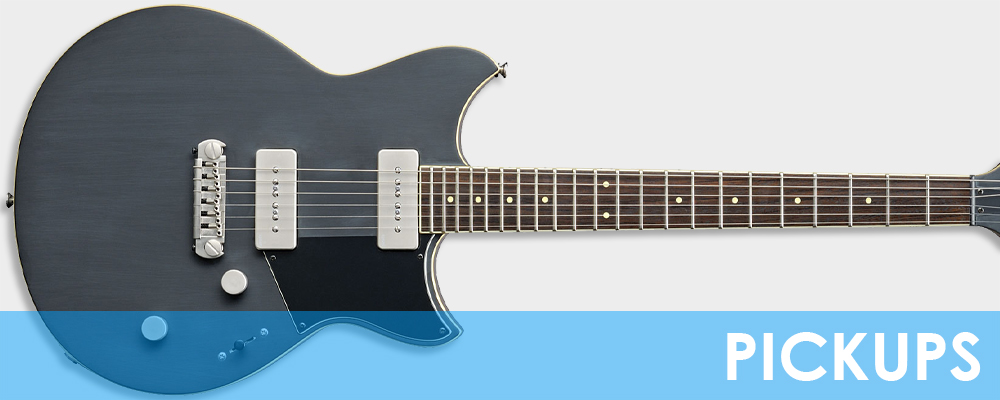
The pickups are loaded to the front of the guitar, under the strings. They are made from magnets wrapped in coils of wire and convert the strings’ vibrations into electrical signals to be amplified. Pickups have a huge influence on the overall tone of the guitar and come in different types and configurations.
Pickup types
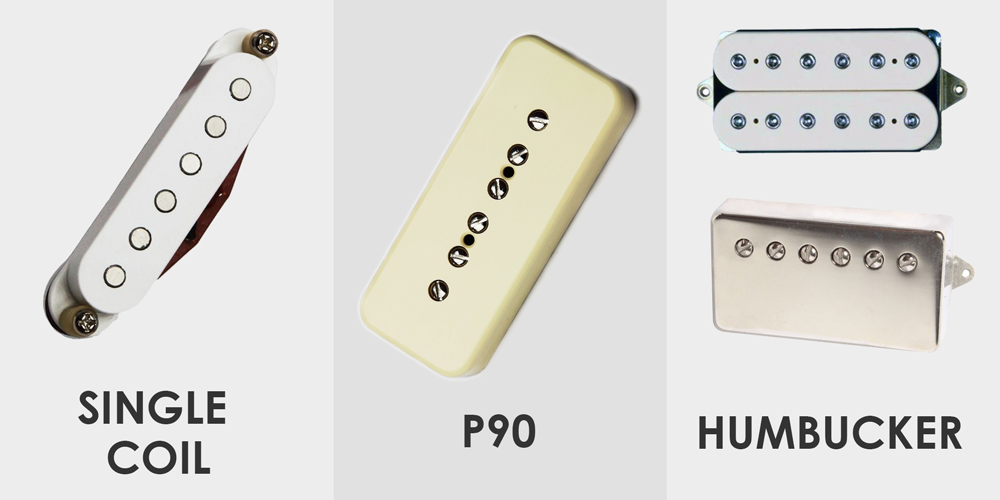
- Single Coil: generally, a lower-powered option with a brighter and more nuanced tone. Think of the sounds of Biffy Clyro, Mark Knopler from Dire Straits, or Bruno Mars with his song “Uptown Funk”. They’re very versatile pickups and are great for pop, blues, soul, funk, rock, and country.
Single coils have an inherent background ‘hum’ due to the nature of their design (more noticeable under lighting and near computer monitors) – don’t worry, though; many great guitarists have used them over the decades.
- P90: a vintage-style pickup with a ‘half-way’ tone between single-coils and humbuckers. They have the nuance and brightness of a single-coil with some of the ‘bite’ of a humbucker – a very versatile choice!
- Humbucker: a more powerful pickup with two coils mounted back-to-back. They are perfect for blues, rock, and metal. The dual-coil design is noise-cancelling: the humbucker literally ‘bucks’ the background ‘hum’ found in single-coil pickups.
- Active: some of the guitars you’ll see have a 9V battery and are labelled with ‘active pickups’. This simply means the pickups have additional power and a stronger sound – ideal for rock and metal.
Pickup configurations
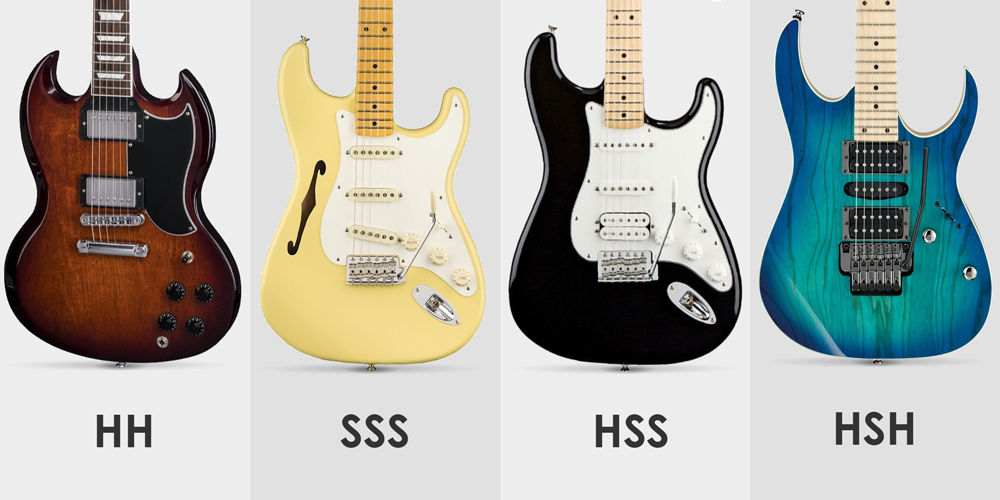
- HH – twin humbuckers with a powerful sound that’s perfect for rock and metal.
- SSS – three single coils with a balanced and nuanced tone. Great versatility as they usually have a 5-way switch to select five different sounds from the guitar.
- HSS – a humbucker for powerful rock tones, combined with two single-coil pickups for nuanced lower-gain sounds: a very versatile range of sounds that can cover almost all genres.
- HSH – commonly seen on ‘shred’ guitars designed for speed and high-octane playing. A very versatile pickup configuration that blends the best of humbucker and single-coil tones.
Bridge
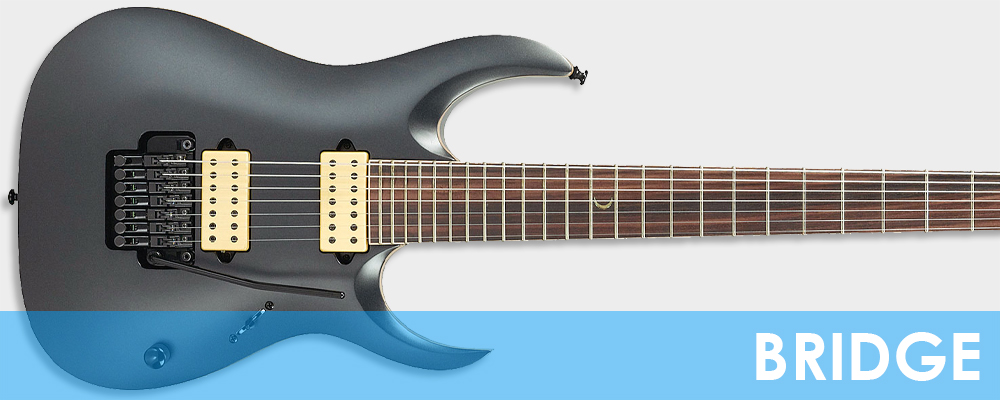
The bridge is the where the strings connect with the guitar. While the standard bridge is fixed with no movement, some guitars have a tremolo system which allows you to manipulate the pitch of the strings using the “whammy bar”. Different bridges and tremolo systems feature adjustment points for the action and intonation of the guitar (two topics beyond the scope of this article!).
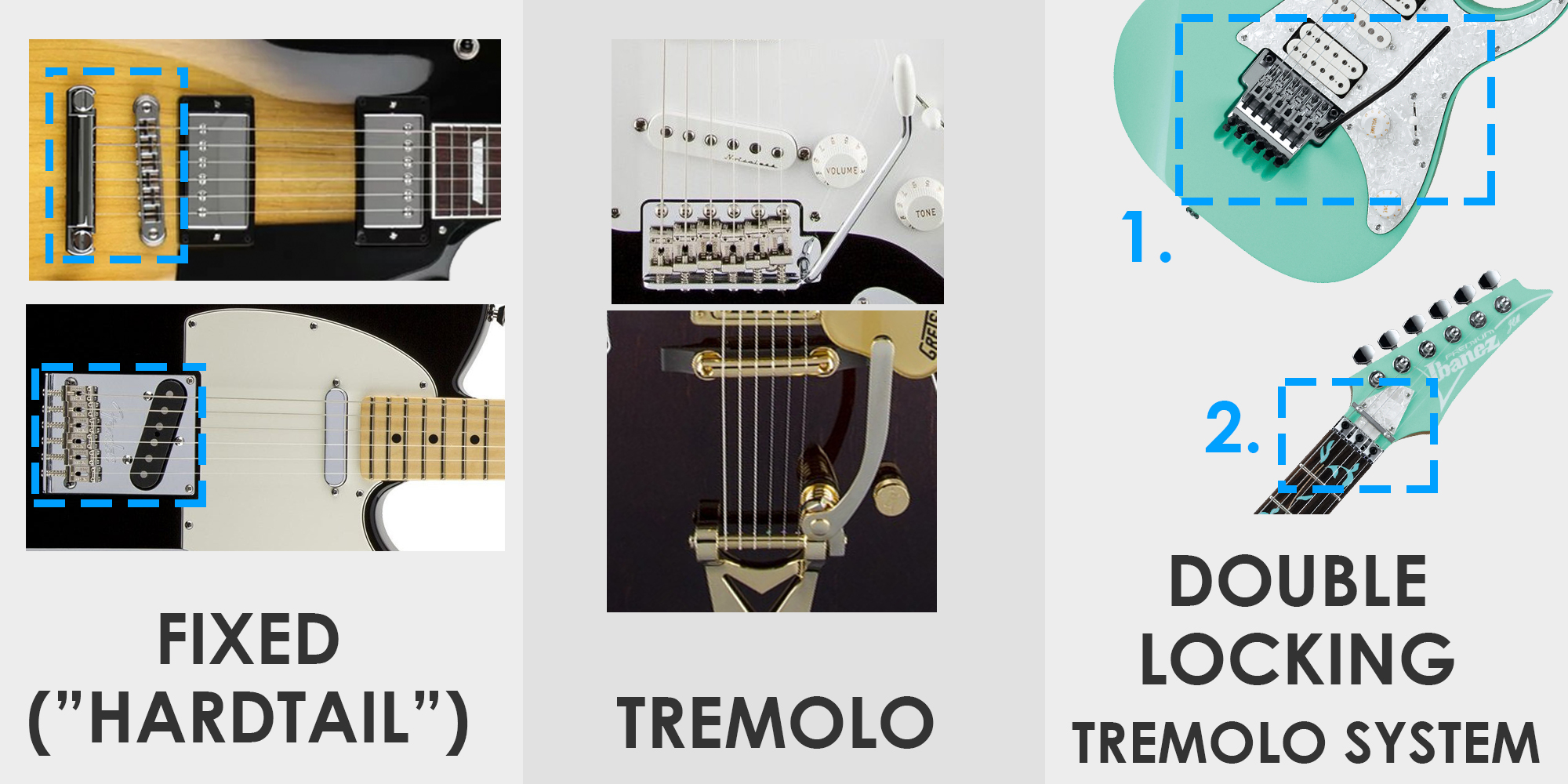
- Fixed bridge: no bridge movement. It generally has better sustain and tuning stability.
- Vintage-style tremolo: a moving bridge with a “whammy” bar letting you adjust the pitch of all six strings at once. These guitars require tuning more often, as use of the tremolo over time will affect the guitar’s pitch.
- Double locking tremolo: the double locking tremolo (like the Floyd Rose brand) features a moving tremolo as above, but the strings are “locked” in place in two places on the guitar, so cannot slip during whammy bar use. This means you can perform some truly extreme whammy bar tricks (think of Dragonforce, Steve Vai, or Van Halen with their ‘extreme’ effects) and not worry about going out of tune. The downside of locking tremolos is the setup and maintenance required, not to mention the added difficulty of changing strings.
Find out more
Now that you’re all clued up on finding the perfect electric guitar for you, why not explore our full guitar range?

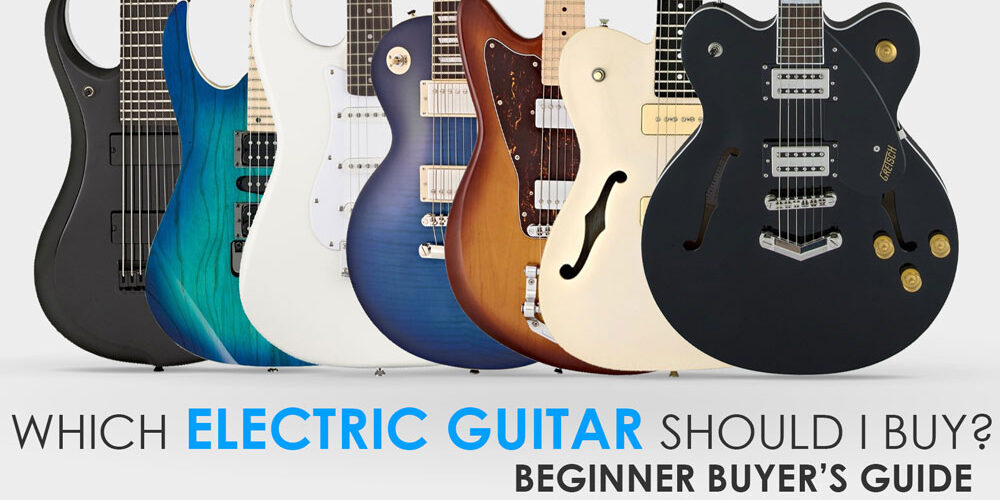












0 Comments